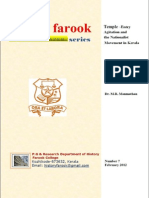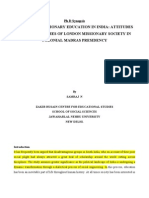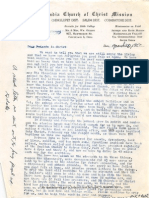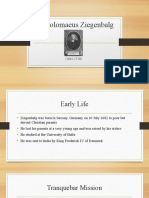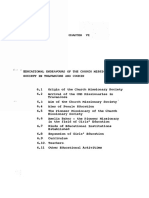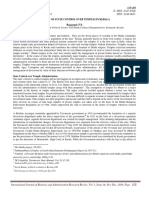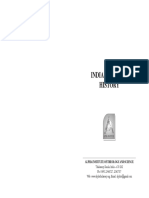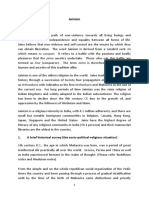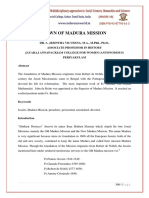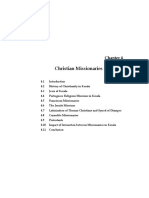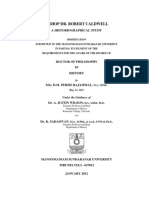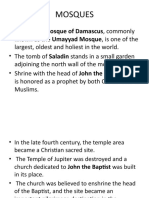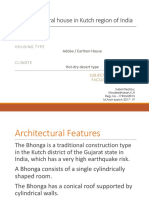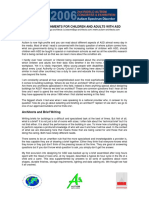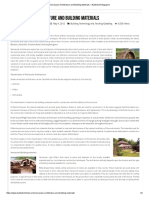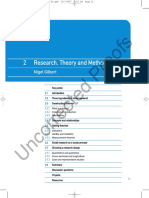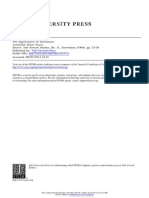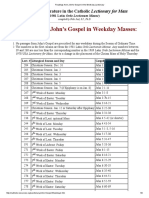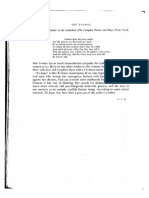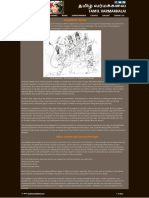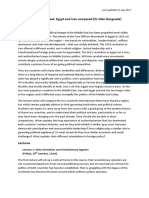INTRODUCTION
The study area covers the present Kanyakumari District of Tamil
Nadu. Before independence, it was part of the then princely state of
Travancore. After independence, by the abolition of the native states Act
of 1949, the neighbouring states of Travancore and Cochin merged and
formed the State of Travancore and Cochin. Again due to the demand for
the re-organization of the states on linguistic basis in 1956, the State of
Kerala was formed with the area of Malabar being merged with the State
of Travancore–Cochin. The four taluks of southern Travancore, namely
Agastheeswaram, Thovalai, Kalkulam and Villavancode, where most of
the people speak Tamil, were formed as Kanyakumari District, and on 1st
November 1956 merged with the Madras State.1 For the merger,
Movements were started under the leadership of Mr. A. Nesamony, a
prominent politician, who belonged to the Church of South India.2
Kanyakumari District has a total area of 1684. 4 square kilometres
lying between 05’ and 77 36’of the eastern longitude and 8 03’ and 8 35’
of the northern latitude. Bounded by Tirunelveli District in the east and
1. Maria John B., Linguistic Reorganization of Madras Presidency, Nagercoil, 1994,
P. 168.
2. Gnanadasan, J., A Forgotten History : The Story of Missionary Movement and the
Liberation of the People in South Travancore, Madras, 1994, pp. 145 -152.
1
�Kerala in the north, but the sea had washed away the west and south. The
population of the District as per the Census of 2011 is 18,53,727.3
The District has the highest population of 992 persons per square
kilometer as against the state average of 372. The highest percentage of
literacy is 63.86, next to Chennai city, far above the state average of 46.76
percent and it is attributed to the impact of Christianity. A close scrutiny of
the Census from 1951 to 2001 indicates the unprecedented rise of Christian
population. The steady growth of Christians from 38 per cent in 1951 to 40
per cent in 1961, from 48 per cent in 1971 to 52 per cent in 1981, and from
58 per cent in 1991 to 60 per cent in 2001 – 2011 to 65 per cent,
undoubtedly was due to missionary initiatives.4
The backward communities of this area were converted to
Christianity under the able leadership of missionaries of various
denominations. Nineteenth century witnessed severe social evils and
injustice on the backward and downtrodden communities. They were
denied to cover their bosoms and wear upper clothes. For centuries caste
Hindus considered it an insult if lower caste women dared to appear before
3. Census of India 2011, Kanyakumari District Handbook, Madras, 2011, p. 1-2.
4. Sundararaj T., ‘Hindu Christian Conflict in Kanyakumari District’, in Alasiar, ed.,
Christianity in South India, Thirithuvapuram, 2006, p. 130.
2
�them covering their bosom.5 The socio-cultural and politico–economic
disabilities enforced vigorously the labeled depressed communities of this
region greatly to favour the missionaries to engage themselves actively not
only in preaching the Gospel but also in motivating them to introduce
various welfare measures to uplift the people.6 The missionaries rooted
Christian faith in the Indian culture and in the religious life of the people.7
The spread of Christianity in Kanyakumari was a landmark. The Church
played an active role in shaping and sharpening the socio- economic life of
the people. The grass – root level organizing structure of the Catholic
Church today is the Basic Christian Communities.8 The transformation
they brought into the Church questioned the monopoly of the Priestly
hierarchy and its arbitrary stand on issues affecting the welfare of the
people.9
CATHOLIC DIOCESE OF KOTTAR
The Catholic Diocese of Kottar established in 1930 marked a turning
point in the history of Catholic Christians in Kanyakumari District. The
5. Agur, C.M., Church History of Travancore, Appendix xviii, p.1.
6. Joseph Prasad, P., Inculturation through Basic Christian Communities,
Bangalore, 1985, p. 1.
7. Ibid.
8. Edwin, M. J., ‘Basic Human Communities’, in Vaiharai, Thirichirapalli, 2002,
p. 25.
9. John Damascene, N., ‘Challenges to the Basic Christian Communities’, op. cit.,
p. 51.
3
�new Diocese was carved out of the Diocese of Quilon to promote the
propagation of Catholic faith within the confines of Nanchilnadu.10 Bishop
Lawrence Pereira was consecrated as the first Bishop of the Diocese of
Kottar. The newly formed Diocese had 95,000 Catholics, 25 parishes, and
32 priests.11 The second Bishop T. R. Agnisamy was consecrated in Rome
on 29 October 1939.12 As a man of simplicity, he established a father–
children relationship among the people in the Diocese. Under him
numerous community expansion works were undertaken in places, mainly
in the mission centres, as neither did the coastal parishes nor did the settled
parishes of the interior gave scope for fresh conversions. When he took
charge of the Diocese in 1939, there were 39 parishes, but at the time of
his retirement in 1971 the number of parishes were 68, the number of
Churches and chapels had risen from 123 to 257, the number of priests
increased from 41 to 117, and the number of convents from 10 to 49.13
The third Bishop Marianus Arockiasamy took charge on 17th
February 1971.14 He became the modern dynamic architect of the Diocese
of Kottar. He kept many personal contacts with the people in various walks
10. Marieli Benzigar, Arch Bishop Benziger, California, 1977, p.461.
11. Lawrence, V., History of Catholic Church in Kanyakumari District, Nagercoil,
P. 102.
12. Ibid., P. 106.
13. Ibid., p. 114.
14. Narchison, J. R., Called to Serve : A Profile of the Diocese of Kottar, Nagercoil,
1983, p. 234.
4
�of life, particularly with the religious, whom he inspired, encouraged and
offered spiritual help with his pleasing personality. He introduced
inculturation and decentralization of diocesan administration through the
Basic Christian Communities.15 Bishop Leon A. Tharmaraj was elevated as
the fourth Bishop of Kottar and took charge on 5th February 1989.16 By his
vision and mission, the Basic Christian Communities became the way of
life of the Diocese.17 The present Bishop Peter Remigius took the
canonical possession of the Diocese on 24 August 2007.18 The process of
decentralization in their regime ceased to be merely an issue of
administrative reforms but became an object of mass mobilization and
popular participation in the Parishes, Vicariates and Diocesan levels.19
This study aims at finding out how much the Diocese of Kottar
developed by the Bishops Marianus Arockiasamy and Leon A. Tharmaraj
established the decentralised structures in the Diocese through Basic
Christian Communities.20 As Bishops, the heads of the local Church, their
mission was to promote lay leadership in the Church and society. They
15. Bishop’s Circular, No. 19/ 1993.
16. Kottar News Letter (KNL), Bishop’s House, Nagercoil, February 2007, p. 34.
17. Ibid., p. 35.
18. Circular of Diocesan Administrator, No. 16/ 2007.
19. Arokiasamy, M., The Christian Life and Ministry in the Diocese of Kottar,
Nagercoil, 1986, p. 13.
20. Report of Coordination of the Pastoral Commissions, in KNL, Nagercoil, 2003,
p. 138.
5
�devolved 75 – 80 per cent of their mission plan outlay for projects and
programmes to be formulated and implemented by local Parish
administrations. A mass movement – popularly known as Basic Christian
Communities for decentralised planning – was then launched to empower
local self structures to prepare plans in a transparent and participatory
manner.21 This thesis has been prepared after a thorough investigation of
the field of Basic Christian Communities namely Anbiyams in the Diocese
of Kottar during the period from 1978 to 2013. The performance of the
Bishops stand out superior to that of its predecessors and successors, and
this thesis is critically analysed on the development of democratization of
diocesan administration during these 35 years.
BASIC CHRISTIAN COMMUNITIES AND DEMOCRATIZATION
Basic Christian Communities otherwise called as Anbiyams in
Tamil was introduced in the Diocese of Kottar in 1970. From 1987
onwards it began to function systematically in the grass – root of all the
parishes of the Diocese. Anbiyams have been accorded top priority in the
Diocese. The Anbiyams has come to stay as the democratic way of life,
21. Ibid.
6
�and it became a decision making centre from bottom to top in the
Diocese.22
This has been an excellent forum for people’s participation and
community–based programs. It plays a pivotal role in the diocesan
administration.23 It is a forum to hold fair discussions on issues related to
the society and Church and collective planning for social change. Anbiyam
has been involved in the preparation, motivation and evaluation of 3250
cells in 175 Parishes and its substations in the Diocese of Kottar.24 The
Diocese of Kottar understood the importance of democratic
decentralization and paved the way for the development of the Vicariate
centres namely Kottar, Colachel, Mulagumoodu and Thirithuvapuram.
After the establishment of Anbiyams in twenty seven zones, there has been
a rise in the participation of people in different fields of the Vicariates. The
Diocese has set up many structures in order to realize Diocesan goals in
22. Conclusions of Diocesan Synod – 2000, Bishop’s House, Nagercoil, 2001, p. 25.
23. Maria David, A., Beyond Boundaries: Hindu Christian Relationship and Basic
Christian Communities, Delhi, 2009, p. 117.
24. Annual Report of Anbiyam, Bishop’s House, Nagercoil, 2013, p. 75.
7
�decentralization through the Basic Christian Communities.25 Though it is
an ideal in its own right, its instrumental significance depends upon the
linkages with socio- political and cultural life of the people. It is an attempt
to solve some of the keenly felt need of grass – root people through mass
participation. The intensely participatory Anbiyam activists and
empowering nature of Diocesan decentralization experiment makes it
worthy of study by advocates of democracy everywhere.
HYPOTHESIS
The research work analyses the various factors that contributed for
the decentralization process. In the past, the Diocese of Kottar ignored the
Catholics to participate in the activities of Church and society except
spirituality. As man is always innovative; the democracy does not also
remain static, but it keeps changing in tune with the progress of man’s
innovative mind. As far as the Diocese is concerned, it has to promote all
newly emerging trends. Bishops Marianus Arockiasamy and Leon
25. Family movement, charismatic movement, Social Action Movement, Societies,
Bible discussion group, the legion of Mary, the St. Vincent De Paul Society, etc.,
have close personal relationships, but there is no community of life among the
members. Religious communities like Jesuits, Dominicans, etc. all themselves as
communities. However, they differ from BCC, because they are open only to
those who wish to embrace the religious life; they live in households, rather than
in different houses in neighbourhood. Hence, BCCs are meant for grass – root
organizations in planning and decision making.
8
�A. Tharmaraj in their period acquainted well in fulfilling this obligation on
their part. They could achieve all- round developments of the Diocese as
their ministerial colleagues worked hard for social transformation. They
cooperated with Bishops to issue a number of circulars to the parishes to
develop Basic Christian Communities, in view of decentralizing diocesan
administration. With the full support and cooperation of the Diocesan
mechanism, the Bishops initiated Anbiyams. It marked the beginning of a
remarkable period in the annals of the Diocese of Kottar, which is noted
for far reaching changes in the socio-religious life of the people.
Basic Christian Communities and its participatory structures operate
at Parish, Vicariate and Diocesan levels. With this frame work, democracy
is defined in all Parishes, Parish Pastoral Councils, Vicariate Pastoral
Councils and Diocesan Pastoral Councils due to the monopoly of Priests in
the Diocese. Increasingly, they have come to agree whatever may be in
principle, laity now argue, in practice one must appease religious and
cultural sensibilities because such sensibilities are so deeply felt.
The Diocesan priests made special efforts to co-ordinate Basic
Christian Communities with the aims and goals of the Diocese. The priests
perceived Anbiyams as the only means to reform the Church and society.
They wanted to give proper motivations to Catholics for their involvement.
9
� The study reveals the fact that the social transformation in the
Diocese is mainly due to the contribution of the Basic Christian
Communities in decentralization. Further it is known that, socio - religious
and interrelationship among the people and the Anbiyams came into being.
OBJECTIVES OF THE STUDY
1. To analyse critically the nature, scope and meaning of the term
Basic Christian Communities in global and local context.
2. To revaluate the functions of the Basic Christian Communities
in Kanyakumari District.
3. To study the organizing structure of grass – root level Catholic
Christians and the hierarchical networks.
4. To assess the contribution of the Basic Christian Community for
economic and social developments.
5. To understand the changing roles of the lay people and the
priestly hierarchy.
6. To estimate the role of Anbiyam, its impact on the life of the
people, and to explore how much social change has taken place
in the society through the democratization of diocesan
administration.
10
� 7. To evaluate the activities of diocesan administration, after the
establishment of the grass - root structures in the Diocese.
SCOPE AND IMPORTANCE OF THE STUDY
Bishops Marianus Arockiasamy and Leon A. Tharmaraj had the
dream of developing the Diocese of Kottar not only to preach the word of
God but also to promote participation of the people in Church and society.
In all spheres they were fortunate to become the Diocesan Bishops in 1971
and 1988. They were best administrators to push forward the vision and
mission of the Church. By their hard and sacrificing works, they succeeded
in establishing Anbiyams throughout the Diocese. As practical Bishops,
they found the effectiveness of the Anbiyams and initiated steps to
implement all the programs allotted through Anbiyams. Their Vicar
Generals and Anbiyam Directors implemented the programs and brought
about participatory development in the District, and thus, a study of the
Basic Christian Communities under their reign assumes importance.
Christianity did a great contribution to the social change of Small
Christian Communities since 1960s. It is being increasingly recognized
that micro-level planning and people’s participation are essential for
efficient progress in the living conditions and sustainable development of
the local population. It is hoped that this study will provide the first level
11
�of information from the communities for the purpose of planning to social
change. It is also possible that the contents and approach adopted for
decentralization in this study will encourage Catholics all over the country
to study Anbiyam.
An understanding of this study enables the readers to analyze and
understand the forces that shape the present method of Anbiyam and to
formulate solutions for various problems faced by the society. It is a
fervent desire that readers will find this study useful and thought
provoking. May be it will also encourage Catholics of the other Districts of
Tamil Nadu and beyond to do research in their respective Districts.
The acute unemployment and widespread poverty, especially in the
rural areas of Kanyakumari District, which had been prevailing in the last
quarter of twentieth century, had been demanding of the then governments
to initiate concrete steps to address these twin issues. The two Bishops, M.
Arockiasamy and Leon A. Tharmaraj took up the task of promoting
democratization of diocesan administration in the Diocese. However, this
process is an ideal and Basic Christian Communities are in need of
necessary supports.
Several non - formal studies have already been undertaken about the
Basic Christian Communities in the district of Kanyakumari under these
12
�Bishops. But sormal study on this was not systematically done so far. A
study on the grass – root development of any region will be complete only
if it covers all the aspects connected with the establishment and the nature
of structures. Especially the Diocesan programmes are the structures
executed from the Basic Christian Communities. In this aspect, this study
covers all facts of socio – political and cultural development through
Anbiyam which these Bishops had brought about. It is part of humble
effort to explore ways to promote peoples participation in the diocesan
administration. Hence, the scope of this study is to assess the clergy
reaction to democratization of diocesan administration in the light of
Anbiyam attitudes towards Christianity.
One of the initiatives arising from the study is to prepare a thesis on
democratization approach and the researcher has undertaken field studies
in various parts and structures of the diocese. It is of special interest to
laity as well as the students of Church history and other historians and
scholars today.
DESIGN OF THE STUDY
The thesis is designed into seven chapters excluding an introduction
and conclusion. In the introduction a brief sketch about the District,
Catholic Diocese of Kottar, Basic Christian Communities and
13
�democratization, Hypothesis, Objectives, Scope of the Study and
Methodology adopted for the preparation of the thesis are dealt with. The
first chapter ‘Historical background of the Diocese of Kottar’ analyses the
cultural background of Kanyakumari District, growth of religion and
culture of the people, cultural profile of the coastal people, the profile of
the Catholic people of the interior and adaptation of local culture and
conversion. It brings out hour Catholic Church developed as an
indigenous cultural religion from the beginning. People from all sections
of the society embraced the new Diocese attracted by the inculturation. Its
official encounter is engaged with world realities.
The Diocese of Kottar took up the task of establishing Basic
Christian Communities. Its concept and meaning were explained in the
Biblical context. Its general features and organization structures were
discussed sociologically and historically. The BCCs have admirably
succeeded in concretizing the new vision of the Church as the people of
God as proposed by Vatican II. Original ideal of Christian life is rooted
from New Testament of the Holy Bible. The programme of Basic Christian
Communities which originated in Latin America is gaining momentum and
popularly in many parts of the world. India also promoted these
communities as a form of Christian life. In Tamil Nadu, the Parish renewal
14
�ministries were established on the line of Vatican II and achieved many
things in history. All these are examined in the second chapter, ‘Historical
profile of Basic Christian Communities’.
The third chapter ‘Grass – root level Christian structures in Kottar
Diocese’ analyses Basic Christian Communities as carrying out the council
documents. It was introduced in Kottar Diocese as a religious movement in
renewing Church and society. It emerged as Anbiyams, focusing on local
Church as a communion of communities. The Diocese of Kottar took it as
a challenging innovative task for the multifarious growth of the Diocese.
Anbiyam had succeeded in making every parish of the Diocese a highly
suitable one for achieving anything as its personalities are behind.
The fourth chapter ‘The territorial and administrative structures of
the Basic Christian Communities’ describes the territorial divisions of the
Diocese, various structures of decentralization, rules and regulations of
election of Parish Council, vicariate regional administration and diocesan
administration. It focused attention on decentralization process and people
– centred Church.
The fifth chapter ‘The relation between Christian Community and
Church administrative hierarchy’ deals with administrative structures of
BCCs, functions of the Parish Coordinating committee, various stages of
15
�training programmes for establishing BCCs, activities of BCCs, Parish
Coordination Council, Vicariate Co-ordination Council and Coordination
Committee of the region. Anbiyam Commission played a decisive role in
the progress of the socio-economic and religious transformation in the
Diocese.
The sixth chapter ‘Basic Christian Communities and Integral
Development Societies’ is popular among the Christians in a large scale, in
the social work field of Kottar Diocese. Its objectives, structure of
Kuzhithurai Integral Society, Basic Integral Society and its powers and
functions, executive of Villavancode Integral Development Society,
Kuzhithurai Integral Development Social Services and its functions and
etc. are presented as such socio – economic developments are indeed an
emergent sign of the Diocese.
The seventh chapter ‘Social Response of the Basic Christian
Communities’ resolves to eradicate the social evils and work for the up-
liftment of the downtrodden, through the vision and mission motivations of
Anbiyam. There are clear cut instructions and guidance for sensitization
and the concern for the needy has become the regular feature of the BCCs.
They work for the poor towards empowerment programmes. Finally, the
study comes to the conclusion stating that the primary agent of
16
�democratization of diocesan administration is the Basic Christian
Communities. They are the ideal focus of decentralization with which to
start.
METHODOLOGY
The research methodology adopted in the present study is narrative
and analytical and facts are presented with objective look out. An orderly
and relevant narration of events, presentation of facts as they are in a
chronological form and the contribution made by the Diocese of Kottar
based on relevant data. By and large, record based study has been
developed for this work. However, the records which provided the
information were in different forms. The information regarding the
democratization process had to be shifted out from the papers. Personal
interviews help a lot to gather certain important data. This endeavour is
historical. As far as the information on the institutions and commission for
Anbiyam were concerned, it would be gathered by a simple method. The
information gathered from Annual reports, Magazines, monthly leaflets
and field reports shed light on the proposed study.
The situation with the Diocese with regard to information has been
gathered from their historians. The Diocesan circulars, Magazines of the
parishes, Souvenirs and Kottar News Letters were the only records
17
�pertaining to decentralization. In such cases, method of collecting the
necessary information from personal interviews with most suitable persons
in the field of Anbiyam and Kuzhithurai Integral Development Social
Service was adopted.
SOURCES FOR THE STUDY
The study is largely based on primary sources. Secondary sources
also used. The primary sources are circular letters, personal interviews and
reports from the Diocese of Kottar. Various unpublished theses on the
history of the Diocese of Kottar are also consulted. The secondary sources
mainly are the published books.
The information that the researcher gathered from the periodicals
has helped to form an idea of the late Bishops’ personality and religious
career. The Tamil leaflet ‘Adithalam’ (Official news letter of Anbiyam)
gives a fund of information regarding Anbiyam contributions, and Kottar
News Letter information are of immense value to understand the
conditions of the Church and its approaches.
The information regarding setting up of Basic Christian
Communities and democratization, diocesan administration is available in
the reports of Diocesan Pastoral Commissions, Vicariate Pastoral
18
�Commissions and Parish Pastoral Council specifically in the written
reports of Basic Christian Communities and its coordination in the levels
of Parish, Zones, Vicariates and Diocese. The researcher spent five years
and gathered data through participation in meetings and celebrations. He
recorded some of the commentaries and speeches during the programs.
Different scholars however refer to the history of Christianity in
Kanyakumari District. The most important among them are Nagam Ayia’s
Travancore State Manual, T.K. Velu Piillai’s Kerala State and Tamil
Nadu Gazetteers, C. M. Agur’s Church History of Travancore, K. K.
Pillay’s Studies in the History of India with special Reference to Tamil
Nadu, V. Lawrence’s History of the Catholic Church in Kanyakumari
District, J. Alasiar’s Christianity in South India: a Commemoration-
Volume in Honour of Rev. Fr. J. Lucas (ed), B. Sobhanam’s A History
of Christian Missions in South India (ed), R. R. Daniel’s Citizens’ Report
on The State of Development and Environment in Kanyakumari District
(ed), J.M. Villavarayan’s Diocese of Kottar and Silver Jubilee
Commemorative Volume, J.R. Narchison’s Called to serve, a Profile of the
Diocese of Kottar, Fr. R. Paul Richard Joseph’s From the Venadu Roots,
Fr. A. Maria David’s Beyond Boundaries: Hindu-Christian Relationship
and Basic Christian Communities, James O’ Holloran’ Small Christian
19
�Communities, Kottar Diocesan Platinum Jubilee Souvenir 1930–2005,
T. Sunderaraj’ Some Social Priests of Tamil Nadu (ed), and Then Oli a
monthly published by the Diocese of Kottar, Fr. M. Peter’ Unpublished
thesis of A Comparison between the BCC in Latin America and Eastern
Africa, Fr. G. Patrick’ Religion and Subaltern Agency, KIDS Special Issue
– 2005, Diocesan Pastoral and Circular Letters and Adithalam are also
relevant to the study of the BCCs and decentralization process in Kottar
Catholic Diocese District shed light on the study. The secondary sources
co-operate with the primary data.
20









